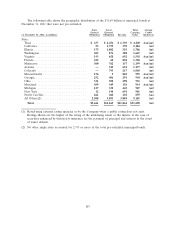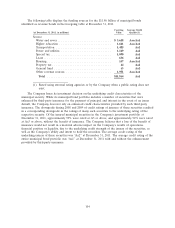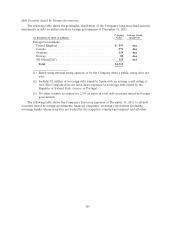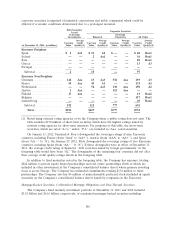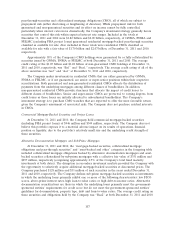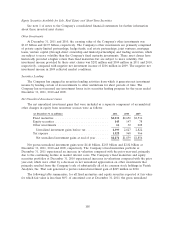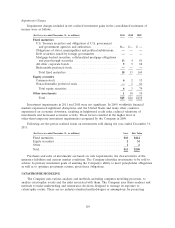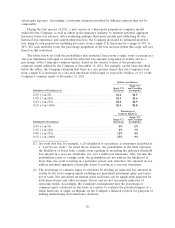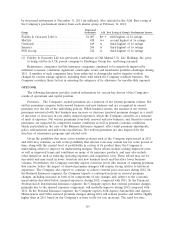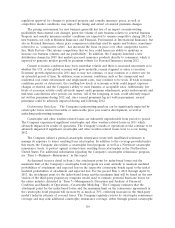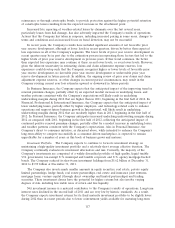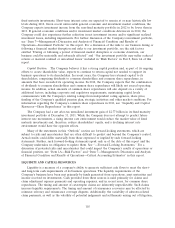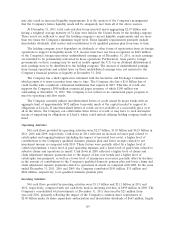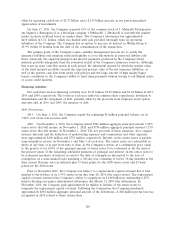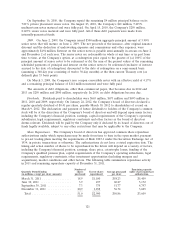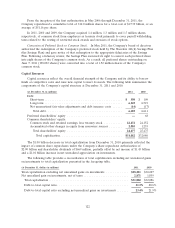Travelers 2011 Annual Report Download - page 124
Download and view the complete annual report
Please find page 124 of the 2011 Travelers annual report below. You can navigate through the pages in the report by either clicking on the pages listed below, or by using the keyword search tool below to find specific information within the annual report.The threshold loss amounts in the tables above, which are based on the Company’s in-force
portfolio at December 31, 2011 and catastrophic reinsurance program at January 1, 2012, are net of
reinsurance, after-tax and exclude most loss adjustment expenses, which historically have been less than
10% of loss estimates. The amounts for hurricanes reflect U.S. exposures and include property
exposures, property residual market exposures and an adjustment for certain non-property exposures.
The amounts for earthquakes reflect U.S. and Canadian exposures and include property exposures and
workers’ compensation exposures. The Company does not believe that the inclusion of hurricane or
earthquake losses arising from other geographical areas or other exposures would materially change the
estimated threshold loss amounts.
Catastrophe modeling relies upon inputs based on experience, science, engineering and history.
These inputs reflect a significant amount of judgment and are subject to changes which may result in
volatility in the modeled output. Catastrophe modeling output may also fail to account for risks that
are outside the range of normal probability or are otherwise unforeseeable. Catastrophe modeling
assumptions include, among others, the portion of purchased reinsurance that is collectible after a
catastrophic event, which may prove to be materially incorrect. Consequently, catastrophe modeling
estimates are subject to significant uncertainty. In the tables above, the uncertainty associated with the
estimated threshold loss amounts increases significantly as the likelihood of exceedance decreases. In
other words, in the case of a relatively more remote event (e.g., 1-in-1,000), the estimated threshold
loss amount is relatively less reliable. Actual losses from an event could materially exceed the indicated
threshold loss amount. In addition, more than one such event could occur in any period.
Moreover, the Company is exposed to the risk of material losses from other than property and
workers’ compensation coverages arising out of hurricanes and earthquakes, and it is exposed to
catastrophe losses from perils other than hurricanes and earthquakes, such as tornadoes and other
windstorms, hail, wildfires, severe winter weather, floods, volcanic eruptions and acts of terrorism. For
these other perils, in contrast to hurricanes and earthquakes, models are less widely used, or are not
used, by the Company and by the industry. Further, compared to models for hurricanes and
earthquakes, models, if any, for the other perils are newer, less reliable (given the even greater
difficulty of predicting the risks) and not as extensively tested.
For more information about the Company’s exposure to catastrophe losses, see ‘‘Item 1A—Risk
Factors—Catastrophe losses could materially and adversely affect our results of operations, our
financial position and/or liquidity, and could adversely impact our ratings, our ability to raise capital
and the availability and cost of reinsurance’’ and ‘‘Item 1A—Risk Factors—We may be adversely
affected if our pricing and capital models provide materially different indications than actual results.’’
CHANGING CLIMATE CONDITIONS
Severe weather events over the last several years have underscored the unpredictability of future
climate trends and created uncertainty regarding insurers’ exposures to financial loss as a result of
catastrophe and other weather-related events. Some scientists believe that, in recent years, changing
climate conditions have added to the unpredictability, frequency and severity of natural disasters.
Accordingly, if climate conditions change in the future, the Company’s catastrophe models may be less
reliable.
The Company discusses how potentially changing climate conditions may present other issues for
its business under ‘‘Risk Factors’’ in Item 1A of this report and under ‘‘—Outlook’’ herein. For
example, among other things:
• Increasingly unpredictable and severe weather conditions could result in increased frequency and
severity of claims under policies issued by the Company. See ‘‘Risk Factors—Catastrophe losses
could materially and adversely affect our results of operations, our financial position and/or
liquidity, and could adversely impact our ratings, our ability to raise capital and the availability
and cost of reinsurance’’ and ‘‘—Outlook—Underwriting Gain/Loss.’’
112



